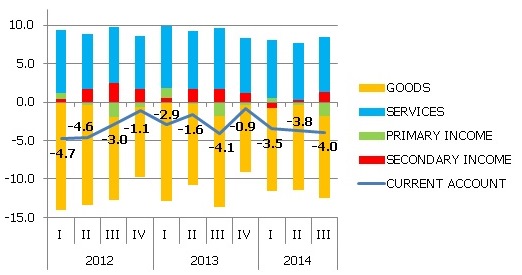Latvian current account deficit is at 250 million euro
In the third quarter of 2014, the Latvian current account had a deficit of 250 mil. euro. The slight increase in the deficit (to -4.0% of gross domestic product (GDP). was primarily on account of an increase in the deficit of primary income (See Chart).
Chart. The main components of current account, % of GDP

The goods and services external trade deficit in the third quarter increased to 215 mil. euro quarter-on-quarter, but, in terms of percentage of GDP, slightly dropped: from 3.5% to 3.4%. Looking at the goods and services accounts separately, the external trade deficit of goods rose in the third quarter, reaching 664.4 mil. euro, which can be explained by a faster increase in goods imports compared to exports. Comparing the data for the quarter in terms of percentage of GDP, the deficit dropped from 10.9% in the second quarter to 10.6% in the third quarter. Even though political discord in Latvia’s eastern neighbours overshadows the growth in the region, growth rate remains positive for the Latvian goods exports (2.6% year-on-year). Evaluating the external trade of services as percentage of GDP, the positive balance dropped from 7.4% to 7.1% quarter-on-quarter, even though, in terms of the actual amount of services exports, their value increased to 449.5 mil. euro. The reason is the increased third quarter GDP compared to the previous quarter. The rise in services exports was primarily promoted by travel and business services.
The negative balance of primary income in the third quarter of 2014 increased to -118.2 mil. euro (-1.9 % of GDP), which was mostly influenced by a drop in European Union (EU) fund subsidies received by Latvia. The positive balance of secondary income account, on the other hand, increased in the third quarter, reaching 83.2 mil. euro (1.3% of GDP), which was impacted by an influx of EU funds or, more exactly, finances from the European Social Fund, which was greater than in the previous quarter, personal transfers between resident and non-resident households and other current transfers. According to the income budget distribution of foreign financial assistance (incl. EU funds), the implementation of the public projects of various sectors of the economy is continuing in the fourth quarter, therefore an additional influx of finances is expected also in the last quarter of the year.
In the third quarter of 2014, the positive balance of the capital account contracted to 149.7 mil. euro (2.4% of GDP). These changes were determined by a drop in the inflows of EU funding earmarked for investment in this quarter.
The financial account deficit shrank to 303.3 mil. euro (-4.8% of GDP). This took place primarily on account of monetary financial institutions (excl. central bank) transactions with debt securities.
The protracted political instability in Latvia’s eastern neighbours and the related uncertainty of the economic environment as well as the slow economic recovery in the EU could be the most significant aspects impacting the decision to postpone the launching of new projects and reducing the inflows of investment. In the third quarter, foreign direct investment inflows amounted to 13.5 mil. euro or 0.2% of GDP. Geopolitical circumstances notwithstanding, the international ratings agency "Standard&Poor’s" (S&P) in November confirmed Latvia’s credit rating at the previous level. That testifies to the success of the Latvian economy in balancing the risks. A balanced and responsible economic development should continue also in the future.
Textual error
«… …»




